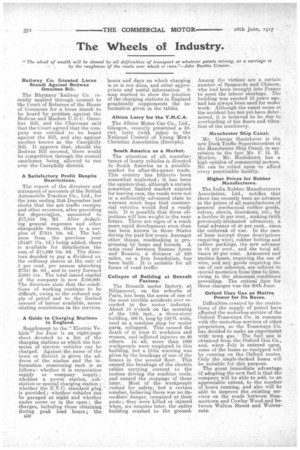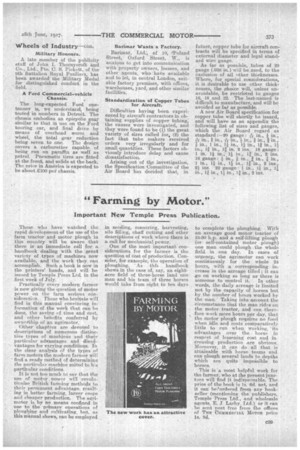The Wheels of Industry.
Page 8

Page 9

If you've noticed an error in this article please click here to report it so we can fix it.
" The wheel of wealth will be slowed by all difficulties of transport at whatever points arising, as a carriage is by the roughness of the roads over which it rans."—John Beattie Crozier. • Railway Co. Granted Locus Standi Against Bedwas Omnibus Bill.
The Rhymney Railway Co. recently applied through counsel to the Court of Referees of the House of Commons for a locus standi to be heard by petition against the Bedwas and Machen IT.D.C. Omnibus Bill, and the Chairman said that the Court agreed that the company was entitled to be heard againstthe Bill, and also against another known as the Caerphilly Bill. It appears that, should the Bedwas Bill succeed, there would be competition through the council omnibuses being allowed to run over the Caerphilly district.
A Satisfactory Profit Despite Restrictions.
The report of the directors and statement of accounts of the British Automobile Traction Co., Ltd., for the year ending 31st December last shows that the net traffic receipts and other revenues, after providing for depreciation, amounted to
217,94419s. After deducting general expenses st9t1 other chargeable items, there is a surplus of 27514 16s. 8d. The balance from the previous year (24407 17s. 1d.) being added, there is available for distribution the sum, of 211,922 13s. 9d. The directors decided to pay a dividend on the ordinary shares at the rate of 5 per cent. per annum absorbing 27341 2s. 9c1., and to carry forward 24591 Ils. The total issued capital of the company is now £150,000. The directors state that the conditions of .working continue to be difficult, owing to the reduced supply of petrol and to the limited amount of labour available, necessitating restrictions in the services.
, A Guide to Charging Stations in England.
Supplement to the "Electric Vehicle" for June is an eight-page sheet devoted to a list of the charging stations at which the batteries of -electric vehicles can be charged: .Against the name of the town or district is given the address of the station and the information concerning each is as follows; whether it is corporation supply or company supply ; -whether a power station, substation or special charging station ; whether the E.V.O. standard plug is provided ; whether' vehicles Can be garaged at night and whether under cover or in the open ; the charges; including those obtaiaing during peak load hours; the
G36 hours and days on which charging i
is or s not done, and other approprints and useful information. A map marked to show the lOation of the charging stations in England graphically supplements the information given in the tables.
Albion Lorry for the Y.M.C.A.
The Albion Motor Car Co.' Ltd., Glasgow, recently presented a 30cwt. lorry (with sides) to the National Council of Young Men's Christian Association (Incorpt).
South America as a Market.
The attention of all manufacturers of heavy vehicles is directed to South America as a possible market for after-the-peace trade. This country has hitherto been somewhat neglected ; it has been the opinion-that, although a certain somewhat limited market existed for touring cars, the roads were not in a sufficiently advanced state to warrant much hope that conaniercial vehicles would find a ready sale. It is possible that these objections will lose weight in the near future. There are signs of a much more rapid development even than has been known • in these States during the past few years. Amongst other things, roadmaking is progressing by leaps and bounds. A main road betw,een Buenos Ayres and Rosario, a distance of 250 miles, on a firm foundation, has been built. It is suitable for all forms of road traffic.
Collapse of Building at Renault Factory.
The Renault motor factory, at Billancourt, on the suburbs of Paris, has been the scene of one of the most terrible accidents ever recorded in the motor industry. About .10 o'clock on the morning of the 13th inst., a three-story building, 490 ft. long by 130 ft. wide, used as a machine shop for motor parts, collapsed. This caused the death of at least 21 workmen and women, and inflicted injuries on 60 others. In all, more than 1000 work-people were employed in this budding, but a little warning was given by the breakage of one of the beams in the second floor. This caused the breakage of the electric cables carrying current to the motors driving the machine tools, and caused the stoppage of these later. Most of the workpeople rushed for safety, but a certain number, believing there was no immediate danger, remained at their posts ; they were killed or injured when, six minutes later, the entire building crashed to the ground.
Among the victims are a certain number of Spaniards and Chinese, who had been brought into France to meet the labour shortage. The building was exected 10 years ago, 'and has always been used for motor work. Although the exact cause of the accident has not yet been determined, it is believed to be due to overloading of the floors and vibration of the machinery.
Manchester Ship Canal.
Mr. George Hazlehurst is the new Dock Traffic Superintendent of the Manchester Ship Canal, in succession to the late Mr. F. G. H. Morton. Mr. Hazlehurst has a, high opinion of commercial 'motors. He tan be relied upon to afford .every practicable facility.
Higher Prices for Rubber Manufactures.
The India Rubber Manufacturers Association, Ltd.; notifies that there has recently been an advance in the prices of all manufactures of general mechanical rubber goods, valves, sheets, insertions, etc., by a further 10 per dent., making (with previously-intimated advances), a total advance of 40 per tent., since the outbreak of war. In the case of hose .(eXcept those descriptions requiring wire), rubber belting and rubber packings, the new advance is 15 per cent., and the total ad-, Vance 50 Per cent. Armoured and suction hoses, requiring the use of wire, and any goods requiring the use of raw asbestos, are subject to special quotation from time to time, owing to the abnormal conditions prevailing. The critical date for these. changes was the 20th June.
Oxford Uses Gas as Motive Power for Its Buses.
Difficulties created by the, restrielions of the supply of petrol have affectedthe motorbus service of the Oxford Tramways Co. in common with the motorbus services of other proprietors, so the Tramways Co. has decided to make an experiment with' town. gas. The fuel gas is obtained from the, Oxford Gas Co., and, when July is entered upon, some of the buses so equipped will be running on the Oxford routes. Only the single-decked buses will be suitalale for this purpose.
The great immediate advantage of adopting the new fuel is that the company will be able' to add, to an appreciable extent, to the number of buses running, and also will be able to improve the .existing services on the roads between SUMmertown and Cowley Wood.and between Walton .Street and Iffolvercote.
Military Honours.
A late member of the publicity staff of John I. Thornycroft and Co., Ltd., Pte. C. S. Pickett, of the 9th Battalion Royal Fusiliers, has been awarded the Military Medal for distinguished conduct in the field. .
A Ford Commercial-vehicle Chassis.
The long-expected Ford onetonner is, we understand, being tested in numbers in Detroit. The chassis embodies an epicyclic gear similar to that in use on the Ford touring car, and final drive by means of overhead worm and wheel, the total gear reduction being seven to one. The design covers a carburetter Capable of being run on paraffin as well as petrol. Pneumatic tires are fitted at the front, and solids at the back. The price in America. is expected to be about £100 per chassis. Barimar Wants a Factory.
Barimar, Ltd:, of 10, Poland Street, Oxford Street, W., is anxious to get into communication with 'property owners, lessees, and other agents, who have available and to let, in central London, suitable factory premises, with offices, warehouses, yard, and other similar
Standardization of Copper Tubes for Aircraft.
Difficulties having been experienced by aircraft contractors in obtaining supplies of copper tubing, the causes were investigated, and they were found to be (1) the great variety of sizes called for, (2) the fact that tube makers received orders very irregularly and for small quantities. These factors obviously introduce delay and cause dissatisfaction.
Arising out of tile investigation, the Specification Committee of the Air Board has decided that, in future, copper tube for aircraft contracts will be specified in terms of external diameter and legal standard wire gauge. As far as possible, tubes of 20 gauge (.036 in,) will be used, to the exclusion of all other thicknesses. Where, for special considerations, it is desirable to use other thicknesses, the -choice will, unless unavoidable, be restricted to gauges 16, 18 arid 22. The last-named is difficult to manufacture, and will be avoided as faf as possible.
A new Air Board specification for copper tube will shortly be issued, and will have as an appendix the following list of sizes and gauges, which the Air Board regard as standard :-20 gauge : 14s in., in., is-e-in., in., ir in., in., in., in., -711./ 1 in in., 11 in., l in., 1,1 in., 11 in., 11 in. 2 ins. 18 gauge :
1 in. . 11in., ij in., 2 ins.
16 gauge : 1in., ji in., in., 1 in., l in., 1 in., 14. in., 2 ins., 2% ins. 22 gauge : 1 in., 1 in., Vs in., 11 in., 1.1 in., 11 in., 2 ins.




















